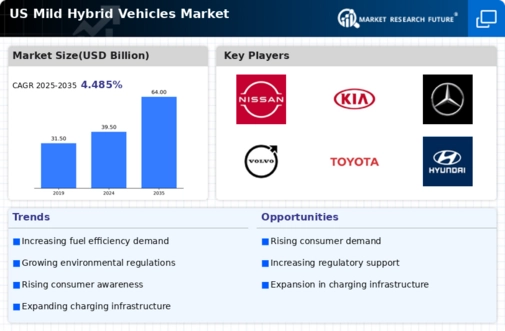The competitive landscape of the US Mild Hybrid Vehicles Market is characterized by a dynamic interplay among key automotive manufacturers aiming to capture a share of the growing demand for sustainable transportation solutions. As consumers increasingly seek fuel-efficient and environmentally friendly driving options, the market for mild hybrid vehicles has gained traction. This market features a mix of established companies and new entrants, each leveraging technological advancements and diverse product offerings to enhance their competitive positioning. Additionally, the regulatory environment, consumer preferences, and advancements in battery technology play pivotal roles in shaping the competitive strategies adopted by these companies.
The market's growth is further fueled by incentives for greener vehicles and a shifting focus on reducing carbon emissions, prompting manufacturers to innovate and expand their mild hybrid portfolios.Nissan has established a solid presence in the US Mild Hybrid Vehicles Market, leveraging its extensive experience in the automotive sector. Known for its commitment to innovation and sustainability, Nissan has made concerted efforts to integrate hybrid technologies into its vehicle lineup. The brand benefits from a strong reputation for reliability and quality, attributes that resonate with environmentally conscious consumers looking for fuel-efficient options.
Furthermore, Nissan's investments in research and development have led to the creation of advanced hybrid systems, enhancing the performance and efficiency of its mild hybrid models.
The brand's distribution network in the US is well-developed, allowing for better accessibility and improved customer service, which bolsters its competitive stance in the market.Kia has also positioned itself favorably within the US Mild Hybrid Vehicles Market, focusing on a diverse range of product offerings that cater to different consumer segments. The company's portfolio includes several mild hybrid models that combine performance with improved fuel efficiency, appealing to eco-conscious buyers. Kia's strengths lie in its stylish design, affordability, and a robust warranty program that enhances customer satisfaction.
The brand has made strategic investments in technology and innovation, pushing forward with advancements in hybrid systems and electric mobility. Additionally, Kia's commitment to sustainability is evidenced by its strategic partnerships and collaborations aimed at enhancing its product range in the mild hybrid segment. The company’s presence in the market has been bolstered through effective marketing strategies and an expanding dealer network, ensuring that it remains competitive amidst growing demand for mild hybrid solutions.


























Leave a Comment